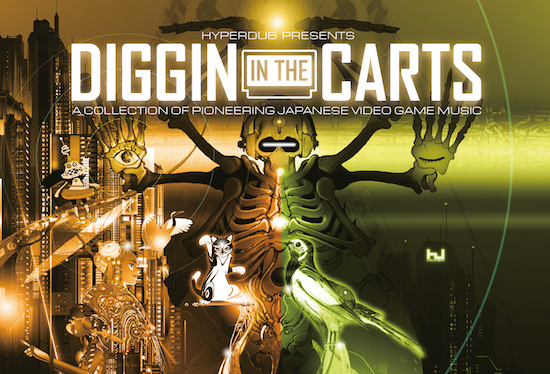The genesis of Diggin’ In The Carts: A Collection Of Pioneering Japanese Video Game Music is in a six-part documentary series produced by Red Bull Music Academy in late 2014. Charting the rise of Japanese 8-bit and 16-bit video game music, and the influence its producers had on popular western culture, the series put a spotlight on a number of unknown composers and explored the socioeconomic and technological factors that fed into the music’s rise, and its downfall.
The series was tied together by the writing, production and narration of Nick Dwyer, a video game music obsessive who now presents the Diggin’ In The Carts radio show for RBMA. So naturally he was drafted in to share curation duties on this new compilation alongside Hyperdub founder and label head Steve Goodman, better known as Kode9. Hyperdub is a natural home for a compilation exploring the Japanese video game music of the tail end of the 20th century: Goodman introduced many to the video game-inspired sub-genre that he termed ‘sinogrime’ just under a decade ago via a clutch of mixes, and the label has also hosted video game-adjacent music from Ikonika, Zomby, Quarta 303 and even Burial, among others, since its founding in 2005.
This compilation, 34 tracks in all, is the result of two years’ work by Dwyer and Hyperdub. They’ve dug up some of the lesser-known gems of the chip era, from systems like the Famicom and Super Famicom, which fell out of favour during the 90s with the advancement of 32-bit and CD technology. Much of the music here, and the associated video games, will be new to even the more seasoned gamer.
Opening on the theme for the 1989-released Cosmic Wars by Konami’s in-house sound team, a raft of illuminating synths bursts through from the get-go. Where today’s video game music reflects the technological developments of the past three decades – in the pop and hip hop-heavy soundtracks of franchises like Fifa and Grand Theft Auto – the music on Diggin’ In The Carts is coloured by a kind of sweet naivety, tied fast to the era in which it was produced and the tools with which it was realised.
Arriving in short, sharp bursts (many of the tracks come in at little over two minutes) there’s a dizzying array of sounds on offer across the compilation – a fact made all the more astonishing by the technological limitations composers had to work around at the time. ‘Hidden Level’, a piece by Michiharu Hasuya lifted from 1986’s Solomon’s Key, lilts around a flute-like melody; the high-BPM rush of ‘A Planet Of Plants’, taken from Nemesis 2, creates the kind of adrenaline rush associated with a particularly fast-paced, difficult video game level. ‘BGM 3’, from Motocross Maniacs, is perhaps the most stripped-back, chiptune-aligned piece on the compilation, while The Legend Of Valkyrie’s ‘King Erekiman’ sounds like a minimalist take on grime. Elsewhere, Soshi Hosoi takes inspiration from the minimalism of Steve Reich on ‘Mister Diviner’ from The Majhong Touhhaiden on one of the compilation’s more extended pieces. The result is a wave of twinkling arpeggios underpinned by the occasional burst of a muffled kick drum – a combination that’d certainly succeed, you imagine, in heaping pressure on any gamer.
By removing this music from its original context, Dwyer and Goodman ask us to consider the composers of the early video game era as highly influential figures. The music is given a chance to take centrestage, even when it’s difficult to take these pieces in without also visualising their place within a video game, real or imagined.
Speaking to The Fader recently, Goodman said that he was less interested in evoking warm childhood memories than in exposing the talents of a whole wave of producers who used technology beyond its means. And the influence of these composers can be heard across electronic music today. Grime is an entire genre steeped in video game music history, while producers such as Hudson Mohawke, Yamaneko, Nightwave and the previously mentioned Ikonika and Quarta 303 have made no secret of the influence that various eras of video games, and their associated soundtracks, have had on them.
Diggin’ In The Carts isn’t your average listen, and it might not be a record you return to over and over, or listen to from start to finish, due to its very nature. It is, however, a thrilling insight into an era of music without which certain reaches of current electronic music would not exist. These 34 tracks charge through a range of emotions, much like each corresponding video game did three decades ago.


